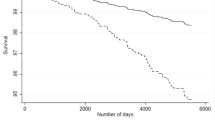Abstract
In 1984–85, 1855 elderly residents of an urban community responded to a comprehensive baseline interview that included questions regarding an extensive set of sleep characteristics and problems. During the subsequent 3 1/2 years of follow-up, 16.7% of the respondents died and 3.5% were placed in nursing homes. The predictive significance of each sleep characteristic for mortality and for nursing home placement was determined separately for males and females, using Cox proportional hazards models. Selected demographic and psychosocial variables were also entered into the models. Age, problems with activities of daily living (ADL), self-assessed health, income, cognitive impairment, depression and whether respondents were living alone were controlled for statistically.
Of the many variables analyzed, in males insomnia was the strongest predictor of both mortality and nursing home placement. For mortality, the relative hazard associated with insomnia exceeded the hazards associated with age, ADL problems, fair-poor health and low income. For nursing home placement, the hazard associated with insomnia exceeded that associated with cognitive impairment. The relationships of insomnia to mortality and nursing home placement were U-shaped, with a worse outcome if insomnia complaints over the preceding 2 weeks were either prominent (numerous or frequent) or absent. For females, insomnia was a borderline predictor of mortality and did not predict nursing home placement at all. Symptoms of the restless legs syndrome predicted mortality for females in some Cox regression models. Reported sleep duration, symptoms of sleep apnea and frequent use of hypnotic drugs did not predict mortality or nursing home placement in either sex.
Similar content being viewed by others
References
Kripke, D, Simons, R, Garfinkel, L, et al. Short and long sleep and sleeping pills: is increased mortality associated? Arch Gen Psychiatr 36:103, 1979.
Kaplan, GA, Seeman, TE, Cohen, RD, Knudsen, LP, and Guralnik, J. Mortality among the elderly in the Alameda County study: behavioral and demographic risk factors. American Journal of Public Health 77:307–312, 1987.
Kelman, H and Thomas C. Hospital and ambulatory service use by the urban elderly under different health care delivery systems. Medical Care 26:739–749, 1988.
Radloff, LS. The CES-D scale: a self-report depression scale for research in the general population. Applied Psychological Measurement 1:385–401, 1977.
Pollak, CP, Perlick, D and Linsner, G. Sleep in the elderly: survey of an urban community. Sleep Research 15:54, 1986.
Van den Hoed J, Coleman, RM, Miles, LE, Guilleminault, CC, Zarcone, VP, and Dement, WC. Sleep-wake disorders in the elderly: a polysomnographic analysis. J Am Geriatr Soc 29:289–296, 1981.
Sanford, IRA. Tolerance of debility in elderly dependents by supports at home: Its significance for hospital practice. Br Med J 3:471–473, 1975.
Pollak, CP and Perlick D. Sleep problems and institutionalization of the elderly. Sleep Research 16:407, 1987.
Hammond, EC. Some preliminary findings on physical complaints from a prospective study of 1,064,004 men and women. Am J Public Health 54:11, 1964.
Wingard, DL, and Berkman, LF. Mortality risk associated with sleeping patterns among adults. Sleep 6:102–107, 1983.
Partinen, M, Jamieson, A, and Guilleminault, C. Long-term outcome for obstructive sleep apnea syndrome patients. Chest 94:1200–1204, 1988.
Ancoli-Israel, S, Kripke, DF, Mason, W, and Kaplan, OJ. Sleep apnea and periodic movements in an aging sample. Journal of Gerontology 40:419, 1985.
Institute of Medicine: Sleeping Pills, Insomnia, and Medical Practice. National Academy of Sciences, Washington, D.C., 1979, page 51.
Callaghan, N. Restless legs syndrome in uremic neuropathy. Neurology 76:359, 1966.
Snider, SR, Fahn, S, Isgreen, WP, et al. Primary sensory-symptoms in Parkinsonism. Neurology 26:423, 1976.
Coleman, R, Pollak, C, Borowiecki, B, and Weitzman, ED. Periodic movements in sleep (nocturnal myoclonus): relation to sleep disorders. Annals of Neurology 8:416–421, 1979.
Diagnostic classification of sleep and arousal disorders. Sleep 2:1–137, 1979.
Author information
Authors and Affiliations
Additional information
Charles P. Pollak, M.D. is Director Institute of Chronobiology Department of Psychiatry New York Hospital-Cornell Medical Center White Plains, New York; Deborah Perlick, Ph.D. is Supervising Psychologist in Neuropsychology Department of Psychiatry Montefiore Hospital and Medical Center New York, New York; Jerome P. Linsner, Ph.D. is Research Associate Institute of Chronobiology Department of Psychiatry New York Hospital-Cornell Medical Center White Plains, New York; John Wenston, M.A. is Research Associate Department of Epidemiology and Social Medicine Montefiore Hospital and Medical Center New York, New York; Frank Hsieh, Ph.D. is Assistant Clinical Professor Department of Epidemiology and Social Medicine Albert Einstein College of Medicine New York, New York
This research was supported by grant numbers PO1 AG03424 and RO1 AG08125 from the National Institute on Aging.
Rights and permissions
About this article
Cite this article
Pollak, C.P., Perlick, D., Linsner, J.P. et al. Sleep problems in the community elderly as predictors of death and nursing home placement. J Community Health 15, 123–135 (1990). https://doi.org/10.1007/BF01321316
Issue Date:
DOI: https://doi.org/10.1007/BF01321316




